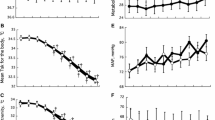Abstract
The aim of this study was to investigate cardiovascular changes, particularly in forearm and calf blood flows, in response to acute emotional stress in men and women. The study was approved by the Ethics Committee of the Queen's Medical Centre, Nottingham University.
Fifty-six healthy non-smokers (29 men and 27 women) aged 19 to 22 years participated. Blood flow was measured by venous occlusion plethysmography using mercury-in-silastic strain gauges. Acute emotional stress (2 min) was elicited by a visual orientation task. During acute emotional stress, there were increases in heart rate (males=40±3%, females=49±5%) and mean arterial pressure (males=24±2%, females=22±2%), and hyperaemia and vasodilatation were observed in the forearm (males=162±15%, females=239±31%) and calf (males=78±16%, females=131±24%). Vasoconstriction also occurred in some subjects. Forearm vasodilatation was significantly greater than calf vasodilatation. Gender variation was apparent in the calf, where vasodilation was significantly greater in females, and vasoconstriction was significantly greater in males.
In some subgroups of men and women, mean values indicated that acute emotional stress elicited increases in forearm, but not in calf, blood flows and vascular conductances. This pattern is similar to that reported by Ruschet al. (see text), but the present findings indicate that vasodilatation in the forearm and calf in response to acute emotional stress is more common.
Similar content being viewed by others
References
Brod J, Fencl V, Hejl Z, Jirka J. Changes underlying blood pressure elevation during acute emotional stress (mental arithmetic) in normotensive and hypertensive subjects.Clin Sci 1959; 18:269–279.
Blair DA, Glover WE, Greenfield ADM, Roddle IC. Excitation of cholinergic vasodilator nerves to human skeletal muscle during emotional stress.J Physiol 1959; 148:633–647.
Lindqvist M, Kahan T, Melcher A, Bie P, Hjemdahl P. Forearm vasodilator mechanisms during mental stress: possible roles of epinephrine and ANP.Am J Physiol 1996; 270:E393-E399.
Halliwill JR, Lawler LA, Eickhoff TJ, Dietz NM, Nauss LA, Joyner MJ. Foream sympathetic withdrawal and vasodilatation during mental stress in humans.J Physiol 1997; 504:211–220.
Rusch NJ, Shepherd JT, Webb RC, Vanhoutte PM. Different behaviour of the resistance vessels of the human calf and forearm during contralateral isometric exercise, mental stress and abnormal respiratory movements.Circ Res 1981; 48(suppl. 1):1118–1130.
Anderson EA, Wallin GB, Allyn LM. Dissociation of sympathetic nerve activity in arm and leg muscle during mental stress.Hypertension 1987; 9 (Suppl. III):114–119.
Linde B, Hjemdahl P, Freyschuss U, Juhlin-Dannfelt A. Adipose tissue and skeletal muscle blood flow during mental stress.Am J Physiol 1989; 256:E12-E18.
Whitney RJ. The measurement of volume changes in human limbs.J Physiol 1953; 121:1–27.
Hokanson DE, Sumner DS, Strandness DE, Jr. An electrically calibrated plethysmograph for direct measurement of limb blood flow.IEEE Trans Biomed Engl 1975; 22:25–29.
Denison DM, Ledwith F, Doulton EC. Complex reaction times and simulated cabin altitudes of 5000' and 8000'.Aerospace Med 1966; 34:1010–1913.
Cooke JP, Creager MA, Osmundson PJ, Shepherd JT. Sex differences in control of cutaneous blood flow.Circulation 1990; 82:1607–1615.
Freedman R, Sabharwal SC, Desai N. Sex differences in peripheral vascular adrenergic receptors.Circ Res 1987; 61:581–585.
Author information
Authors and Affiliations
Rights and permissions
About this article
Cite this article
Butt, C., Pathmadeva, C. & Spencer, C. Forearm and calf blood flow in response to cortical arousal in normal male and female subjects. Clinical Autonomic Research 9, 103–107 (1999). https://doi.org/10.1007/BF02311767
Received:
Accepted:
Issue Date:
DOI: https://doi.org/10.1007/BF02311767




